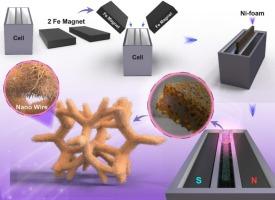磁场诱导排列合金镍铁纳米线电催化氢和氧动态生产
IF 4.6
3区 材料科学
Q2 MATERIALS SCIENCE, MULTIDISCIPLINARY
引用次数: 0
摘要
在大表面积上优化镍铁纳米结构至关重要。本研究在泡沫镍上制备了排列良好的Ni-Fe纳米线,旨在提高催化活性、电荷传输和耐久性。在化学浴沉积过程中使用两个铁氧体永磁体,与无磁引导形成的无序形貌(150-180 nm)相比,该方法产生了均匀的NWs (55-64 nm)。通过场发射扫描电镜(FESEM)、透射电镜(TEM)和电化学阻抗谱(EIS)的表征证实了纳米结构的改善,并将电荷转移电阻从20 Ω降低到5.2 Ω。电化学性能测试表明,相对于可逆氢电极(RHE),在10 mA/cm2下的过电位为230 mV 1.46 V, Tafel斜率为54 mV.dec−1,表明有效的析氧反应(OER)动力学。电化学活性表面积增加到300 cm2,是衬底的7.5倍以上(40 cm2),增强了反应界面。通过在0.5 a /cm2下在12小时内的最小3 mV变化和在阶跃电位测试中可忽略不计的0.01 V位移来验证耐久性。本文章由计算机程序翻译,如有差异,请以英文原文为准。

Electrocatalytic Hydrogen and Oxygen Dynamic Production via Magnetic-Field-Induced Aligned Alloyed Nickel-Iron Nanowires
Optimizing Nickel–iron nanostructure over large surface areas is critical. This study fabricates well-aligned Ni–Fe nanowires on nickel foam, aiming to improve catalytic activity, charge transport, and durability. Using two ferrite permanent magnets during chemical bath deposition, the approach yielded uniform NWs (55–64 nm) compared to disordered morphologies (150–180 nm) formed without magnetic guidance. Characterization via field-emission scanning electron microscopy (FESEM), transmission electron microscopy (TEM), and electrochemical impedance spectroscopy (EIS) confirmed improved nanostructure alignment and reduced charge transfer resistance from 20 Ω to 5.2 Ω. Electrochemical performance tests depicted an overpotential of 230 mV 1.46 V vs. the reversible hydrogen electrode (RHE) at 10 mA/cm2 and a Tafel slope of 54 mV.dec−1, indicating efficient Oxygen Evolution Reaction (OER) kinetics. The electrochemically active surface area increased to 300 cm2, which was over 7.5 times greater than that of the substrate (by 40 cm2), enhancing reaction interfaces. Durability was validated by a minimal 3 mV change over 12 h at 0.5 A/cm2 and a negligible 0.01 V shift in step-potential tests.
求助全文
通过发布文献求助,成功后即可免费获取论文全文。
去求助
来源期刊

Materials Science and Engineering: B
工程技术-材料科学:综合
CiteScore
5.60
自引率
2.80%
发文量
481
审稿时长
3.5 months
期刊介绍:
The journal provides an international medium for the publication of theoretical and experimental studies and reviews related to the electronic, electrochemical, ionic, magnetic, optical, and biosensing properties of solid state materials in bulk, thin film and particulate forms. Papers dealing with synthesis, processing, characterization, structure, physical properties and computational aspects of nano-crystalline, crystalline, amorphous and glassy forms of ceramics, semiconductors, layered insertion compounds, low-dimensional compounds and systems, fast-ion conductors, polymers and dielectrics are viewed as suitable for publication. Articles focused on nano-structured aspects of these advanced solid-state materials will also be considered suitable.
 求助内容:
求助内容: 应助结果提醒方式:
应助结果提醒方式:


